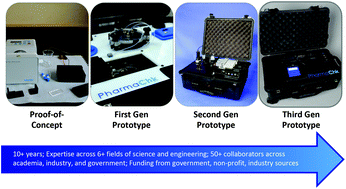PharmaChk: a decade of research and development towards the first quantitative, field-based medicine quality screening instrument
Abstract
Biomedical and clinical scientists play a major role in translating observations into interventions – therapeutics, diagnostics, and medical devices including screening instruments – that improve the health of individuals and the public. This path from observation to intervention is often long and beset with obstacles, many unanticipated. We believe that sharing concrete, real-word examples of scientists in academia moving along this path will highlight some of the types of challenges one may face; here we focus on an intervention being developed by the Zaman lab at Boston University – PharmaChk, the first quantitative, field-based instrument for medicine quality screening. Specifically, this paper describes the first ten years of scientific and engineering work towards the development of this instrument. Launched from a need observed by medicine quality scientists, the development of PharmaChk has required the integration of multiple technologies enabled by knowledge and expertise across diverse fields of science and engineering, including chemistry, ultrasonics, fluid dynamics, optics, computer science, and automation. These efforts have been shaped and driven by the many challenges we have faced and the technical, commercial, and financial support that we have received from many collaborators. By sharing this example, we hope to inspire our colleagues to pursue their own paths to new healthcare solutions.

- This article is part of the themed collection: Analyst Review Articles 2022


 Please wait while we load your content...
Please wait while we load your content...